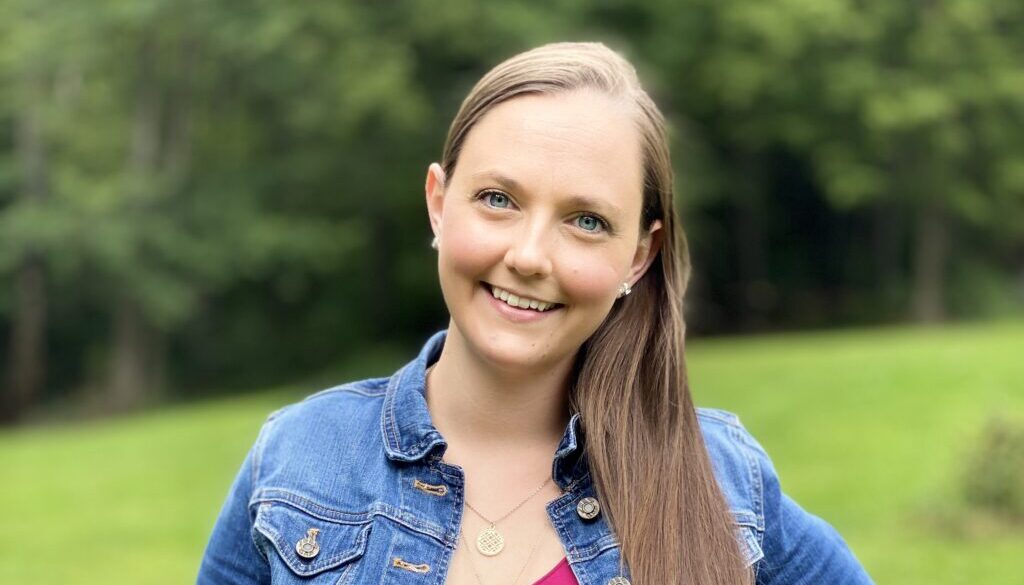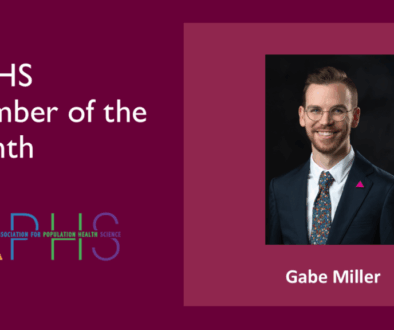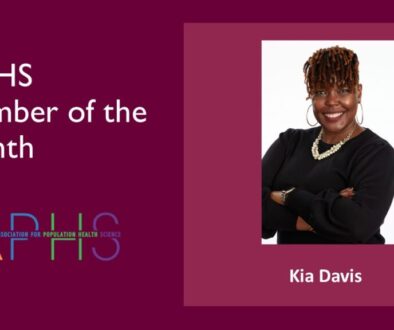Member of the Month: Bobbie L. Johannes
Selena Ortiz, Sara Curran, Muntasir Masum, Sung ParkBobbie L. Johannes is a postdoctoral fellow in the Population Studies Center at the University of Michigan. Her primary research interest aims to reduce access and financial barriers to care among poor, underserved, and rural populations to improve population health. She is specifically interested in the effect of innovative models of care delivery on access to preventive care and the effect of Medicaid expansion on financial barriers to care. Bobbie also examines the social determinants of health, the use of social media to proliferate misinformation, patient perspectives on models of primary care delivery, and the collection of patient-reported outcomes for research purposes.
You can follow Bobbie on Twitter at @b4lynn27
Please share how your work relates to the issues and concerns that have emerged as a result of the COVID-19 pandemic.
Broadly, my research seeks to understand how to improve access to care and eliminate barriers to care for communities and individuals with poor social determinants of health. Being from a rural community, much of my research has focused on rural health disparities. The pandemic has highlighted the strains that rural health systems face from funding to staffing. Prior to the pandemic, 20% of all rural hospitals were at risk of closing. The pandemic has caused more financial strain for rural hospitals due to the need to shut down profitable service lines. Surges of COVID-19 variants in rural communities due to low vaccination rates and health beliefs formed from misinformation have overwhelmed rural hospitals and caused staffing shortages. These disparities require further evaluation to understand how to improve vaccination rates among rural populations and sustain rural health systems to ensure adequate access to care. Moreover, there is a need to better understand how rural health beliefs are formed in order to dispel misinformation that leads to poorer health outcomes and drives disparities.
More specifically, prior to the pandemic, I had evaluated the themes used by vape shops near college towns to market products on Facebook. Therefore, when COVID-19 emerged in the US, I was curious to know what was being said about vaping and COVID-19 within online communities. I used Twitter to identify tweets that mentioned COVID-19 and vape-related terms and identified the themes being used to discuss vaping in the context of the pandemic. Overall, this research highlights the spread of misinformation about COVID-19 on social media.
As a part of my dissertation I evaluated whether rural patients with a patient-centered medical home provider as their usual source of care were more likely to receive a flu shot, these findings may facilitate COVID-19 vaccination efforts in rural communities.
What are some of the long-term implications of COVID-19 on population health?
The COVID-19 pandemic will likely cause a proliferation of health disparities for rural populations. Rural populations are notorious for delaying healthcare until a condition has significantly worsened. This is often the reason that rural populations have higher rates of morbidity and mortality compared to their urban counterparts. Given that the COVID-19 pandemic caused many routine and preventative appointments and screenings to be canceled, it is likely that disease will be caught at much later stages than they would have pre-pandemic. However, one positive implication is the possibility for telehealth appointments. Telehealth is critical for rural populations who often need to travel hundreds of miles in one direction to receive specialty care. If the increased availability of telehealth remains, it may improve access to care for rural populations.
Tell us about your professional journey and how you ended up studying public health and health policy.
As a first generation college student, I really only considered going to medical school as a career path. I participated in Albright College’s scribe program with the Reading Hospital. I loved being a scribe and working in a fast-paced emergency department, but during a shift after Hurricane Sandy I met a patient that changed my career trajectory. The patient came to the ED because they were just “feeling funny” after being without power and only having beer for the past couple of days. The patient’s oral history revealed that this was their first interaction with healthcare in decades and that their quality of life had severely diminished (the patient gave up golf and standing to shower due to untreated atrial fibrillation). I didn’t know it at the time but this was my first introduction to the social determinants of health. This patient made me realize that becoming a physician wouldn’t be fulfilling because there are so many barriers to entry into the healthcare system. I didn’t want to provide “sick care”, instead I wanted to find ways to ensure that people remained healthy throughout their lifetime. With college graduation right around the corner and this sudden shift in what I wanted to do with my future, I found the Masters of Public Health Program at Penn State College of Medicine where I studied health systems organization and delivery. My capstone project was a multi-site exploration of barriers faced by vulnerable populations and the need for targeted interventions in new models of care delivery. At this point, I had fallen in love with research and decided to pursue a PhD in health policy and administration with a dual degree in demography at Penn State University. Growing up in rural Pennsylvania I saw first-hand many of the health disparities that rural populations face, therefore I focused my dissertation on understanding how the patient-centered medical home (PCMH) may or improve access-related barriers to preventive care. With pre-doctoral funding from the Penn State Tobacco Center of Regulatory Science (TCORS) training grant, I also had a strong desire to understand how the PCMH may facilitate smoking cessation. After graduating, I joined the University of Michigan as a postdoctoral fellow in the Population Studies Center.
Can you summarize for us something you’ve been working on recently?
Recently I received a Population Studies Center small grant award to understand how patient-centered medical home (PCMH) components facilitate the use of preventive care among older adults. The purpose of this study is to use factor analysis to develop a scale of PCMH-likeness rather than a binary measure, which may categorize practices transitioning to a PCMH as a non-PCMH. This work is particularly important for rural clinics that may not have the resources to become a certified PCMH. Additionally, I’ve been reviewing literature on rural caregiving to identify the specific needs of rural caregivers and care receivers.
Why did you decide to become a member of IAPHS, and how does IAPHS help you to advance the work that you do?
My mentor, Dr. Selena Ortiz, first introduced me to IAPHS. I decided to become a member because IAPHS provides a forum for interdisciplinary health disparities research. As an early career professional, IAPHS has helped me to grow professionally through the webinars aimed at career development.
Favorite population health relevant academic/news/etc. article(s)?
“The Hot Spotters” by Atul Gawande, published in The New Yorker on January 24, 2011
Hobbies?
In my free time I enjoy exploring local hiking and walking trails with my cocker spaniel, Dash! I also enjoy baking and decorating cakes with my sister.








All comments will be reviewed and posted if substantive and of general interest to IAPHS readers.